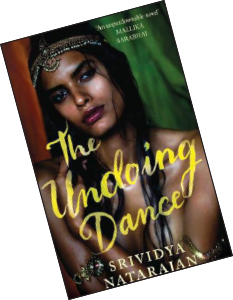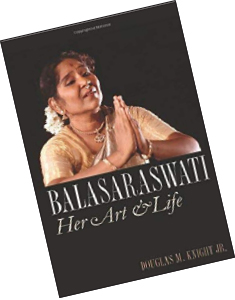

My mother tells this story of a time, back in the 1970s, when she and her sister-in-law decided their families could take care of themselves while they attended every concert they possibly could during the ‘season’ of music and dance in Chennai (then Madras). Balasaraswati, one of the greatest bharatanatyam dancers of India, was performing at the Music Academy and a few minutes into the performance, she expressed dissatisfaction with the mridangam player and insisted he be replaced. Someone was dispatched to find the mridangist of her choice. At the very least it must have taken half-an-hour for the replacement percussionist to take the stage: during that entire time, Bala essayed a range of facial expressions (abhinaya) and hand gestures (mudra) as the vocalist sang the phrase ‘pulli maan’ (spotted deer) over and over again.
You won’t find this story in Balasaraswati: Her Art & Life written by her son-in-law Douglas Knight, but you will find several others, particularly about her legendary grandmother Veenai Dhanammal with whom Bala lived. A high point of the performing arts scene in Madras of those days were the Friday evening veena recitals at the Georgetown residence of Dhanammal, attended by artists, art lovers and members of high society. Balasaraswati told Knight that once, when she was a child, she had introduced herself to someone as the granddaughter of Veenai Dhanammal. Overhearing this, her grandmother had demanded to know who had dared to introduce herself as her granddaughter. That moment, Bala said, she promised herself that her grandmother would one day be forced to identify herself as the grandmother of Balasaraswati. That day came, as the book reveals.
Bala hailed from a family of devadasis of Thanjavur. Dedicated at a young age to the service of a deity in the temple, these women of matrilineal descent were traditionally highly trained and gifted, professional dancers and musicians, and lived under the patronage of powerful, upper class men. During the best of their times, devadasis were powerful and wealthy, but along with British rule came Victorian-era values which, along with other changes in society, resulted in the system gradually degenerating into the exploitation of these women.
As Leela Samson writes in Rukmini Devi: A Life, “The devadasis’ ability to straddle the worlds of private and public life, involving duties in the temple, was truly remarkable. Dance was an ideal and was pursued with diligence. Many devadasis had vast repertoires of compositions which, unfortunately, have been mostly lost to us. For all the ills that society brought upon the community at the time Rukmini was growing up and India finding its voice against foreign rule, it did provide dignity and a vital space for the devadasis to become consummate dancers without the social encumbrances that hold back women.”

Leela Samson records that Bala must have been about 14 and performing at the home of T K Chidambaranatha Mudaliar when Rukmini Devi Arundale, then about 28, first saw her dance. The latter was an upper class woman from a family of theosophists married to an Englishman some 25 years older. She had first been fascinated by the dance of ballerina Anna Pavlova and then sadir or chinna melam, the traditional dance of the devadasis, fascinated enough to want to learn herself. She was in the process of visiting the home of every devadasi in Madras in search of a teacher. That’s what brought her to this house where she was struck by the music of Jayammal (Bala’s mother) and the grace and bhava (emotion) of Bala’s dancing. Eventually she found her teacher in Mylapore Gowri Ammal, a devadasi at the Kapaleeswara temple, renowned for her abhinaya and a close friend of Veenai Dhanammal. Within a year of herself performing publicly at a Theosophical Society event, she established a school of dance and music, later named Kalakshetra. With this she opened the floodgates to hordes of young people from the upper classes learning bharatanatyam which had so long been ‘shunned’ as a thing only ‘certain’ people did.
There’s all this and more in the two books, with their many anecdotes and references to the social, political, economic and performing arts history. In this context, we also briefly meet another pioneering woman, Dr Muthulakshmi Reddy, herself the daughter of a devadasi, the first woman to be admitted to a men’s college and the first woman legislator of India. She set up the Cancer Institute in Madras, only the second dedicated to treating cancer in the country at the time. But what does a doctor-politician have to do with two dancers? Well, she was instrumental in having the devadasi system abolished through a Bill in Parliament that labelled them prostitutes.
The worlds of Balasaraswati and Rukmini Devi come together in Srividya Natarajan’s engaging fictional work, The Undoing Dance, a book I found I couldn’t put down. Perhaps this was because the context of the novel was familiar and fascinating to me personally; perhaps because as a young journalist I had many opportunities to write about dance and dancers; perhaps because at that time both Bala and Rukmini Devi, though old, still commanded great respect and influence; but most of all, perhaps because I was enthralled by their individual stories.

The Undoing Dance gathers the reader into the world of three generations of women in a story set in the context of 13 generations of devadasis. The stories of these three women — Rajayi, Kalyani, Hema — are told in their own voices to which is added the voice of one man, Balasankar, who is upper class but sympathetic to the cause of devadasis, and that of his mother, Vijaya, who spurns them. Kalyani is the second wife of Balasankar who has a child, Hema, by his first wife who dies early. Kalyani longs to dance, but cannot; Hema questions the contradictions in tradition; Rajayi sells flowers near the temple as she recalls her days as a devadasi. There’s more by way of plot that must remain unspoken so as not to ruin the experience of reading the book. Suffice it to say that the lives of the characters crisscross each other, and secrets and sacrifices are revealed as also the politics of power play in the dance field and under social pressure. Dance is at the heart of the story: equally, it brings freedom and imprisonment.
As a book, it’s not perfect, but it resonates at different levels and triggers many questions: about the status of women and dancers in particular, commercialisation of a traditional performing art, role and place of the teacher, caste discrimination, about the way grants and research scholars work, about bhakti (spirituality) and sringara (eroticism) in the context of bharatanatyam and so on.
In an interview to The Hindu in December 2018, the multifaceted author made a thought-provoking comment. She said, “Whatever their intentions, women as powerful and progressive in their own ways as Rukmini Arundale and Muthulakshmi Reddy ended up disempowering Isai Vellalar (the community to which the devadasis belonged) women because they were responding to an ethos in which women’s legitimate public presence depended on the erasure of their sexuality. Arundale genuinely believed that if she did not ‘clean’ off the traces of its devadasi roots, bharatanatyam would be lost to her project of cultural nationalism. Reddy genuinely believed that she needed to equate devadasis with ‘prostitutes’ to make sure there was medical intervention into their ‘immorality,’ which would save them and their children from sexually transmitted diseases. Her solution for performing women was marriage, which is a dubious form of empowerment for any woman, but particularly destructive for courtesans who used their bodies to create art.”
The debate still rages over prostitution, even though sex work is being slowly seen in large sections of society as a legitimate profession. As in everything, there are many sides to the issue as The Undoing Dance unravels. Fundamentally, though, the novel, in Srividya Natarajan’s own words, is “my attempt to articulate the awe and admiration I felt when I saw my Isai Vellalar teachers present their art, and my bafflement at the disappearance of these riches from our collective artistic memory.”
An important feature of the two biographies is the plethora of photographs in them. One of them, c 1937, shows two women, one standing up straight, the other leaning forward, both dressed in striped pyjamas and matching shirts, wearing no bindi, holding cigarettes in their hands, obviously posing in a studio. They are good friends Thanjavur Balasaraswati and Madurai Shanmukhavadivu Subbulakshmi. As they say, a picture is worth a thousand words.
The columnist is a children’s writer and senior journalist.





